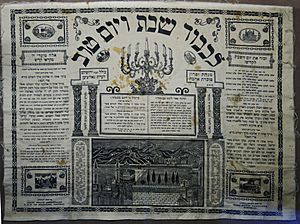Challah cover facts for kids
A challah cover is a special cloth used to cover the two braided loaves of bread, called challah. These loaves are set out on the table at the beginning of a Shabbat (Sabbath) or Yom Tov (holiday) meal. While it makes the table look nice, the cover also has important religious and symbolic meanings.
Contents
What is a Challah Cover?
Challah covers can be made from many different materials, like fabric or even paper. They are often decorated in beautiful ways. People might hand-embroider them, paint them, or use techniques like applique or tie-dye. Some even have fringes with silver or gold threads.
The cover needs to be big enough to completely hide the two challah loaves. You shouldn't be able to see the bread through the sides or the fabric itself. Many challah covers you can buy have special Hebrew words on them. These often say "To honor the holy Shabbat" or "To honor Shabbat and Yom Tov."
Why Cover the Challah?
A Religious Reason
At the start of a Shabbat or holiday meal, Jewish tradition says a blessing, called Kiddush, should be made over wine first. This blessing helps make the day holy. After that, a blessing is made over the bread, which starts the meal.
However, usually, the blessing over bread comes before the blessing over wine. To make sure the wine blessing happens first, and so the bread doesn't seem "shamed" or "left out" by being blessed second, the challah is hidden. Covering it with the challah cover makes it "disappear" for a moment.
If you don't have a special challah cover, you can use something else. A napkin, a doily, or even tissues can work to cover the bread.
Remembering the Manna
The way the challah is placed – under a cover and usually on a tablecloth or cutting board – also reminds people of a story from the Bible. This story is about the manna, which was the special food the Israelites ate every day after they left Egypt.
Moses told the people that manna would fall from the sky every day. But on Shabbat, no manna would fall. Instead, a double portion of manna would fall on Friday. This was enough for Friday and for Shabbat (from the book of Exodus 16:22-26). This is why two challah loaves are used for Shabbat and holiday meals. They represent that double portion of manna.
Every morning, the Israelites found the manna in the fields. It was protected by two layers of dew, one below and one above, keeping it fresh. This made it seem like the manna was carefully packed. So, by placing the challah under a cover and over a tablecloth, Jewish people remember this miracle of the manna at their own Shabbat tables.
History of the Challah Cover
In ancient times, during the period of the Talmud, people ate their meals on small, three-legged trays instead of large tables. Waiters would bring these trays to each guest. On Shabbat, these trays were only brought out *after* the Kiddush blessing was said. This showed that the meal was special because it was for Shabbat, which had just been made holy by the Kiddush.
Today, Jewish families usually set the table with the challah already there. But they keep it covered until after the Kiddush. This tradition still shows that the meal begins only after – and because of – the Kiddush blessing.
The idea of covering the challah so it isn't "shamed" also teaches an important lesson. It reminds people to be kind and thoughtful to others. Just as the bread is "protected" from feeling less important, we should always try not to make other people feel embarrassed or ashamed.
Matzo Covers
During the Passover Seder meal, the matzos (flat, unleavened bread) are also covered. Ashkenazi Matzo covers are often different from challah covers. They might have three "pockets" where the three matzos used at the Seder are placed.
Matzo is sometimes called "poor man's bread." During the Seder, the matzos are uncovered when the story of the Jews' slavery in Egypt is told. But when people raise their wine cups to praise God for their freedom, the matzos are covered again. This is so they won't feel "shamed" because the wine is being given special attention at that moment.
Images for kids






